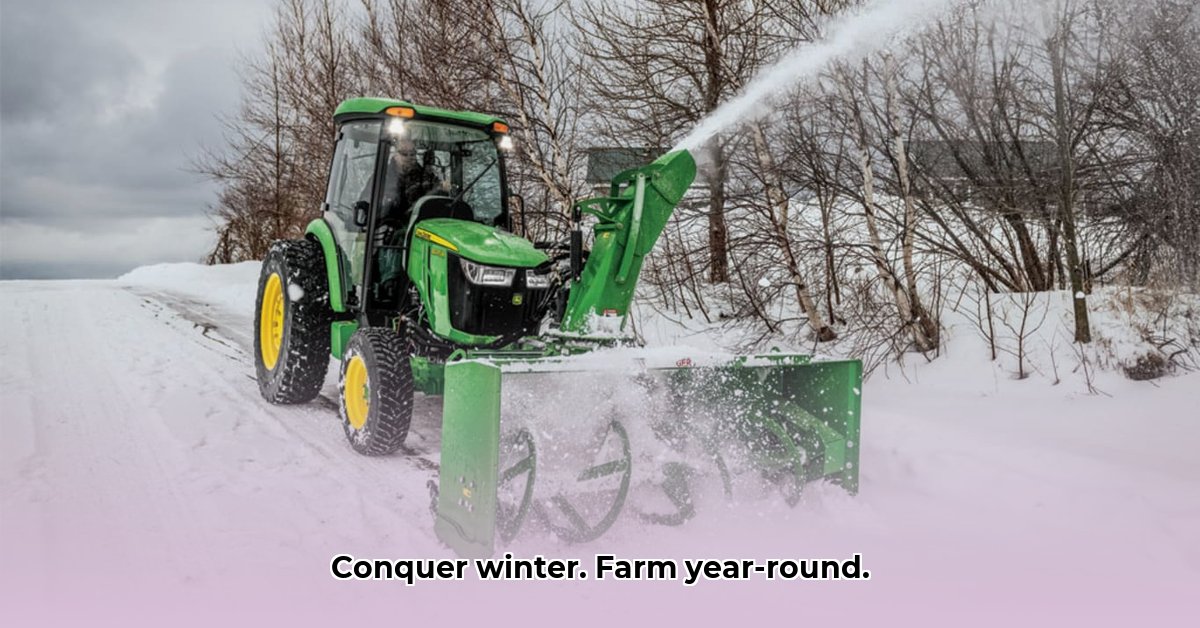
Maintaining year-round farm accessibility is critical for timely operations and maximizing productivity. Winter's challenges, however, can significantly hinder farm activities. This guide demonstrates how John Deere's robust snow removal solutions can ensure continuous operations, regardless of weather conditions. We will cover equipment selection, safe operation, maintenance, and calculating the return on investment (ROI) to help you make an informed decision. For alternative solutions, check out other brands like Kubota here.
Understanding Your Snow Removal Needs
Before investing in snow removal equipment, a thorough assessment of your farm's specific needs is paramount. This involves considering several key factors:
Farm Size and Terrain: Assess the acreage and topography of your farmland. Rolling hills demand more powerful equipment than flat fields. Larger farms require more extensive snow clearing, impacting equipment choice and operational time.
Snowfall Patterns: Analyze historical weather data to understand your typical snowfall patterns. Consider the frequency, intensity, and duration of snowfalls. A region with infrequent, light snowfalls necessitates different equipment than one experiencing heavy, frequent blizzards.
Budget and Financing: Establish a realistic budget for your snow removal investment. John Deere Financial offers various financing options to help spread the cost over time, making the investment more manageable. Consider long-term maintenance expenses alongside the initial purchase price.
John Deere Snow Removal Solutions: A Comprehensive Overview
John Deere offers a diverse range of tractors and utility terrain vehicles (UTVs), complemented by a wide array of snow removal attachments. The right combination ensures efficient and safe snow removal tailored to your specific farm's needs.
Tractor-Based Solutions
John Deere tractors, known for their power and reliability, form the backbone of many snow removal operations. They can be equipped with various attachments, including:
Snow Blowers: Ideal for heavy, wet snow. They propel snow away from the clearing area, making them highly efficient in challenging conditions.
Snow Plows: Best suited for lighter snowfalls and offer faster clearing times compared to snow blowers. They are cost-effective for farms with moderate snowfall.
Spreader Attachments: Crucial for applying de-icing materials like salt or sand, enhancing safety and traction on icy surfaces.
UTV-Based Solutions (John Deere Gator)
For smaller farms or navigating confined spaces, John Deere Gators offer exceptional maneuverability. Their compact size allows for efficient clearing of smaller areas such as driveways, walkways, and around buildings. They can be equipped with smaller snow plows or brooms for efficient snow removal in these specific areas.
Choosing the Right Equipment: A Step-by-Step Guide
Selecting the appropriate snow removal equipment involves a structured approach:
Analyze Snowfall Data: Review historical weather data to predict your typical snowfall. This informs the selection of appropriate equipment based on anticipated snow volume and intensity.
Map Critical Areas: Identify areas requiring priority snow clearance such as driveways, barns, feeding areas, and main access roads. Prioritize based on operational needs and safety considerations.
Assess Terrain: If your farm is hilly or has challenging terrain, a more powerful tractor with superior traction is essential. Flatter areas may allow for smaller, more cost-effective equipment.
Attachment Selection: Choose attachments that match your snowfall patterns. Heavy snow necessitates a snow blower; lighter snow may be handled efficiently by a snow plow.
Budget Allocation: Carefully budget for initial investment costs, ongoing maintenance, and fuel consumption. Explore John Deere Financial’s financing options which help manage costs over time.
Dealer Consultation: Your local John Deere dealer is an invaluable resource. They can provide expert advice, demonstrations, and help you select the optimal equipment for your unique needs.
Operational Considerations: Safety and Efficiency
Prioritizing safety during snow removal is paramount. Always operate equipment according to manufacturer guidelines, and wear appropriate safety gear such as high-visibility clothing, gloves, and sturdy footwear. Regular maintenance is also critical to ensure efficient and safe operation. This includes routine inspections, cleaning, and scheduled servicing to extend the lifespan of your equipment and minimize downtime. Fuel efficiency is also a significant factor, influencing your operating costs over the long term. Selecting an efficient engine can positively impact your return on investment (ROI).
Calculating Your Return on Investment (ROI)
The ROI of investing in snow removal equipment is multifaceted. While the initial cost is significant, the long-term benefits far outweigh the initial investment. To calculate your ROI, consider:
Initial Investment: The total cost of the equipment, including attachments, installation, and any required modifications.
Annual Operating Costs: Factor in fuel, maintenance, and potential labor costs.
Cost Savings: Estimate the cost of snow removal without the equipment (hired services, lost productivity).
Increased Productivity: Quantify the increased efficiency from year-round accessibility.
ROI Calculation: (Annual Cost Savings + Increased Productivity - Annual Operating Costs) / Total Initial Investment.
Conclusion: Maximize Your Farm's Potential
Investing in John Deere snow removal solutions is a strategic move to ensure year-round farm access and operational efficiency. By carefully assessing your needs, choosing the right equipment, and implementing safe operating practices, you can significantly enhance your farm's productivity and profitability. Contact your local John Deere dealer today to begin optimizing your farm's year-round operations.